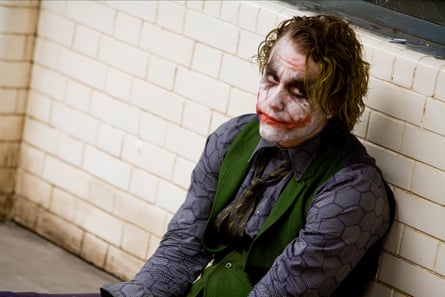Can Christopher Nolan predict the future? Could he have somehow foreseen the eerily specific prescience of Batman’s introduction in 2008’s The Dark Knight, modern superhero cinema’s unwitting blueprint? Christian Bale’s caped crusader doesn’t show his cowled face until a few scenes into the film, after the Joker has pulled off his daring bank heist. Bruce Wayne arrives on the scene to bust up a powwow between some mobsters and guest villain Scarecrow, but he’s preceded by some paunchy copycats armed with shotguns and hockey pads. Their effort to emulate Batman only gets them into trouble, until the genuine article shows up to dispatch the goons with minimal difficulty. Purrs the Scarecrow: “That’s more like it.”
The dour, oppressively grey DC Cinematic Universe is likewise littered with cinematic imitators of Nolan’s vision, having learned all the wrong lessons from Batman’s example. Led by chief architect Zack Snyder, the DC Comics adaptations fell in line behind the gargantuan box office success of Nolan’s films by aping his tone in the hopes that that would be sufficient to recreate the magic. And while box office grosses have for the most part remained healthy, the quality of the films themselves has never come close to matching the rigorous precision, popcorn philosophizing, and sheer cinematic verve of the film now celebrating its tenth anniversary. “We’re going to do this forever, aren’t we?” taunts the Joker, near the tail end of The Dark Knight. Little did he know their psychotic pas de deux would be rehashed over and over again.
Bolstered by an ambitious script from Nolan, his brother (and, elsewhere, Westworld co-creator) Jonathan, and regular DC Comics scribe David Goyer, The Dark Knight ushered in an age of po-faced seriousness – a look that takes a lot of gravitas to pull off. Breaking from a more sprightly, brightly-colored tradition of comic book films best exemplified by Sam Raimi’s Spider-Man pictures, Nolan nudged the genre in the direction of hard realism. Bale’s Batman doesn’t behave like a valiant defender of the defenseless, rather like a hard-nosed cop unencumbered by legal codes of conduct. The Joker, a role that enshrined Heath Ledger in myth following his untimely passing, is no mere super villain, either. He’s an ideological deviant, referred to at least once in the script directly as a “terrorist”, compelled only by the love of violence and chaos. His agenda is chilling in its indifference; he gleefully sets a mountain of money ablaze in full view of the crooks he took it from, just to show them that this is a war fought on principle. He’s the closest thing to nuance that the DC rogues’ gallery has ever seen, and characteristic of a film founded in social theory. The Joker’s grand evil scheme? Sociology thought experiments … made real!

Regrettably, much like dorm-room viewing staple Reservoir Dogs, the legacy of The Dark Knight is superficial. The disciples that followed never probed deeper than the surface in their homage, recognizing a grimmer, moodier Batman without grasping the valid despair that drove him to be so bleak about things. The likes of Suicide Squad, Batman v Superman and Justice League affected a joylessness bastardized from Nolan’s well-founded solemnity. (Matter of fact, a rewatch may surprise a viewer with just how comfortable the script can be with levity. As sardonic butler Alfred, Michael Caine is a deadpan punch-line machine.) The Dark Knight methodically ground the hope and idealism out of its characters one at a time, the Joker’s anarchistic antics breaking the shining symbol of good Harvey Dent (Aaron Eckhart) into blackened pieces.
With Wonder Woman as the emboldened, upbeat exception along with the wisecracking Flash (Ezra Miller, livening up Justice League every time he appeared onscreen), the recent efforts from the DC camp simply slather on the somberness. They mistake world-weariness for outright pessimism, and aspire to nothing more profound than that most overused of registers: “gritty”. The DC canon has more grit than a sandpaper factory, full of grimacing heroes who would fly into the sun before they allowed themselves to crack a smile. They consider wielding power to be a great and terrible burden, just like Batman, but unlike the brutal vigilante protecting a town that nonetheless loathes him, they’re not supported with the motivation for that jaded viewpoint.
More troubling still, DC’s works form the vanguard of a much wider movement towards the homogeneously dark. To varying levels of success, there’s been a mass gritification through Hollywood, affecting everyone from Robin Hood to Universal’s cabal of monster-movie spooks. The Dark Knight’s excellence has been all but boiled down to the single, caveman-simplistic notion that bummer equals mature. Constant flops along the lines of King Arthur: Legend of the Sword have proven otherwise, but this is apparently a lesson that must be learned many times over.
While it’s no fair to hold its unruly offspring against The Dark Knight, it’s all the same frustrating that the rich backlog of comic book arcana from the DC catalogue has never been mined with the same thoughtfulness and technical ingenuity. To paraphrase the film’s pensive final monologue: we’ve been given the releases that DC’s bottom line needs, but not the ones that Batman’s memory deserves.

Comments (…)
Sign in or create your Guardian account to join the discussion